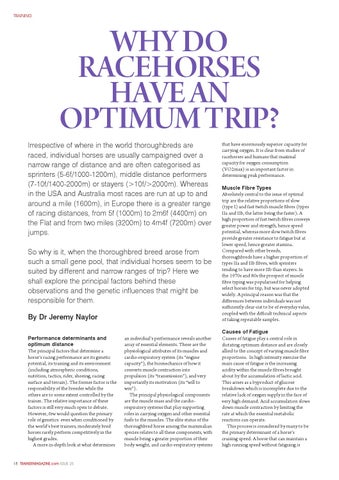DNA.qxd:Jerkins feature.qxd
24/2/09
21:13
Page 1
TRAINING
WHY DO RACEHORSES HAVE AN OPTIMUM TRIP? Irrespective of where in the world thoroughbreds are raced, individual horses are usually campaigned over a narrow range of distance and are often categorised as sprinters (5-6f/1000-1200m), middle distance performers (7-10f/1400-2000m) or stayers (>10f/>2000m). Whereas in the USA and Australia most races are run at up to and around a mile (1600m), in Europe there is a greater range of racing distances, from 5f (1000m) to 2m6f (4400m) on the Flat and from two miles (3200m) to 4m4f (7200m) over jumps. So why is it, when the thoroughbred breed arose from such a small gene pool, that individual horses seem to be suited by different and narrow ranges of trip? Here we shall explore the principal factors behind these observations and the genetic influences that might be responsible for them. By Dr Jeremy Naylor Performance determinants and optimum distance The principal factors that determine a horse’s racing performance are its genetic potential, its training and its environment (including atmospheric conditions, nutrition, tactics, rider, shoeing, racing surface and terrain). The former factor is the responsibility of the breeder while the others are to some extent controlled by the trainer. The relative importance of these factors is still very much open to debate. However, few would question the primary role of genetics: even when conditioned by the world’s best trainers, moderately bred horses rarely perform competitively in the highest grades. A more in-depth look at what determines
18 TRAINERMAGAZINE.com ISSUE 25
an individual’s performance reveals another array of essential elements. These are the physiological attributes of its muscles and cardio-respiratory system (its “engine capacity”), the biomechanics of how it converts muscle contraction into propulsion (its “transmission”), and very importantly its motivation (its “will to win”). The principal physiological components are the muscle mass and the cardiorespiratory systems that play supporting roles in carrying oxygen and other essential fuels to the muscles. The elite status of the thoroughbred horse among the mammalian species relates to all these components, with muscle being a greater proportion of their body weight, and cardio-respiratory systems
that have enormously superior capacity for carrying oxygen. It is clear from studies of racehorses and humans that maximal capacity for oxygen consumption (VO2max) is an important factor in determining peak performance. Muscle Fibre Types Absolutely central to the issue of optimal trip are the relative proportions of slow (type I) and fast twitch muscle fibres (types IIa and IIb, the latter being the faster). A high proportion of fast twitch fibres conveys greater power and strength, hence speed potential, whereas more slow twitch fibres provide greater resistance to fatigue but at lower speed, hence greater stamina. Compared with other breeds, thoroughbreds have a higher proportion of types IIa and IIb fibres, with sprinters tending to have more IIb than stayers. In the 1970s and 80s the prospect of muscle fibre typing was popularised for helping select horses for trip, but was never adopted widely. A principal reason was that the differences between individuals was not sufficiently clear-cut to be of everyday value, coupled with the difficult technical aspects of taking repeatable samples. Causes of Fatigue Causes of fatigue play a central role in dictating optimum distance and are closely allied to the concept of varying muscle fibre proportions. In high intensity exercise the main cause of fatigue is the increasing acidity within the muscle fibres brought about by the accumulation of lactic acid. This arises as a byproduct of glucose breakdown which is incomplete due to the relative lack of oxygen supply in the face of very high demand. Acid accumulation slows down muscle contraction by limiting the rate at which the essential metabolic reactions can operate. This process is considered by many to be the primary determinant of a horse’s cruising speed. A horse that can maintain a high running speed without fatiguing is
